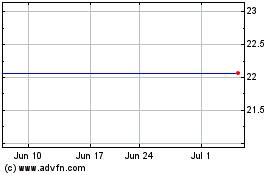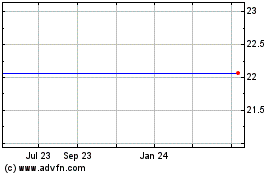By Esther Fung
Shopping malls are going high-tech.
Making technology investments to improve customer experiences
has traditionally been the domain of retailers, which have
introduced robots, touch-screen mirrors and virtual-reality goggles
to attract shoppers to their stores in recent years.
But as pressure from store closures continues to mount, some
mall landlords also are pouring money into technology, investing in
mapping functions to help shoppers find parking spaces, navigate
mall corridors or check out a flash sale at a store one floor
above.
The goal: to better connect with shoppers in hopes of sparking
more activity -- and possibly giving themselves an edge in lease
negotiations with retailers.
"There is one collective bucket of benefits, which is really
about how to improve customer experiences whether in our own
digital assets or in the shoppers' car, mobile phone or watch,"
said Scott Morey, executive vice president at General Growth
Properties Inc., the second-largest mall operator in the U.S. by
number of properties.
Investment from mall owners is also fueling a cottage industry
of technology startups peddling software and services that create
interactive mall maps and mobile advertising, as well as assist in
real-estate maintenance and security operations.
Jibestream, a firm that creates interactive mall maps to guide
customers from store to store on their mobile phones as well as
help them find parking, has rolled out its technology to hundreds
of malls run by Westfield Corp., General Growth and Dubai-based
shopping mall owner and operator Majid Al Futtaim.
"When driverless cars are available, how will they find your
mall and how will they find parking? We'll integrate mapping with
the real-time parking system and make sure where we're guiding
people is closest to where they are going inside the mall," said
Chris Wiegand, CEO at Jibestream.
Other vendors are offering ways for landlords to better analyze
foot traffic in malls, a key metric cited by landlords and
retailers as online shopping continues to gain traction and pose
greater challenges to bricks-and-mortar stores.
Mall owners, who are focused on leasing out their properties and
charging the highest possible rents, are constantly in need of more
precise methods of calculating the number of visitors to their
malls and how they behave.
"We're bringing the same analytics Amazon used to crush
bricks-and-mortar retailers into the real world," said Sage
Osterfeld, chief marketing officer at Palo Alto, Calif.-based
Sysorex.
The data analytics firm uses a real-time location technology
that measures the number of visitors and their dwell times in
various parts of the mall using Wi-Fi, Bluetooth and cellular data
signals emitted by cellphones.
By tracking the cellphone signals in a mall, companies can study
the paths visitors take as well as how effective display windows
and in-mall advertising are in drawing customers.
This is similar to how Amazon.com is able to measure user
engagement by how long cursors hover over a certain part of a
webpage, said Mr. Osterfeld. The technology is able to distinguish
between visitors and staff, and provides insight as to which
storefronts are most popular and which retailers have customers
that fan out to other stores in the mall.
For instance, Apple Inc.'s stores are a huge draw for shoppers,
allowing the tech giant to bargain for lower rents. With this
technology, mall owners will have data regarding how many customers
head straight for the Apple store and then leave without
cross-shopping at neighboring retailers. This could help to put the
floor on rent negotiations.
"Mall operators and developers are very interested in using data
for their advantage in the same way online retailers have been
using data," said Sean Harrington, chief operating officer at
Sensity Systems Inc.
His Silicon Valley-based firm offers smart lighting and sensor
data services that reduce energy costs with added security features
for mall owners. The largest U.S. mall owner, Simon Property Group,
has tapped Sensity's technology for its Brea Mall in California to
improve parking lot lighting, helping illuminate areas that were
too dark for shoppers to find their cars at night.
Some larger mall owners also are investing in startups and
developing their own technology teams to build more intelligent
infrastructures. Simon's venture-capital arm, Simon Venture Group,
invests in retail technology, while Australia-listed Westfield
built its own Westfield Labs in 2012 to address issues on how to
embed digital technology in their projects.
But for landlords who are trying to catch up, it could be
daunting to ferret out which investments might deliver.
"Retailers have been more advanced and sophisticated at
embedding technologies into their business for a long time and
landlords have been a bit behind," said Melina Cordero, CBRE Group
chief of retail research in the Americas. "It can be confusing for
landlords to understand -- it's new technology, new methods of
doing business."
Write to Esther Fung at esther.fung@wsj.com
(END) Dow Jones Newswires
June 07, 2016 05:44 ET (09:44 GMT)
Copyright (c) 2016 Dow Jones & Company, Inc.
GGP Inc. (NYSE:GGP)
Historical Stock Chart
From Mar 2024 to Apr 2024

GGP Inc. (NYSE:GGP)
Historical Stock Chart
From Apr 2023 to Apr 2024
